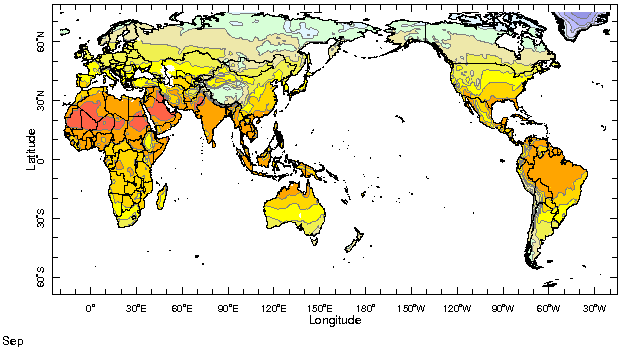|
IRI Climate Digest
October 2003
September Global Climate Summary
Climatological Background
During September, the Northern Hemisphere monsoon systems in West Africa, South Asia, and southwestern North America begin their retreat southward following the maximum solar heating which approaches the equator at the time of the equinox (September 21). Spring has begun in the Southern Hemisphere, with mid-latitude storm tracks losing strength.
Monthly Mean Temperature (1961-1990), data from the Climate Research
Unit, University of East Anglia


Monthly Mean Precipitation (1961-1990), data from the Climate Research
Unit, University of East Anglia


Temperatures
Highlights
The warmth that has gripped Europe for most of 2003 started to ease as the magnitude of the anomalies weakened and their spatial extent shrunk to cover just the northern and western portions of the continent. Above-average temperatures persisted across much of Asia, though they were generally lower than those seen last month in western Asia. Eastern Australia and much of Africa and South America also experienced warmer-than-normal conditions. A variety of conditions were seen in North America with below-normal temperatures in northwestern and south-central portions of the continent and above-normal temperatures along the western coast of the United States and much of the eastern Canada.
Temperature Difference from the 1961-1990 mean, with data
from NCEP Climate Prediction Center, CAMS.


Precipitation
Highlights
Monsoon Summary: During the Northern Hemisphere monsoon season just concluded (July-September 2003) neutral ENSO conditions persisted in the equatorial Pacific, while warm anomalies in sea surface temperature covered much of the tropical Indian and Atlantic Oceans. Overall, the monsoon brought above-average precipitation to Africa and slightly above-average precipitation to India, while drier than average conditions persisted in the Central American-Caribbean region. Continental convergence and rain were more abundant at the northern edges of the global monsoon, in the western Sahel, and from northern India northeastward across to China. Average regional conditions masked a high degree of spatial heterogeneity, e.g. between a wetter northern India and a drier peninsular India, and between a wetter western Sahel and drier eastern Sahel and Gulf of Guinea coast.
Asia: Above-normal rain fell in central India, Southeast Asia, and portions of northeastern China, while drier-than-normal conditions persisted in southern India and southeastern China. Above-normal precipitation associated with tropical systems also fell in the Korean Peninsula. The wet conditions experienced in Japan over recent months were replaced by below-normal precipitation during September.
Africa: The intertropical convergence zone (ITCZ) began its decent southwards during September and brought above-normal precipitation to portions of the Sahel. The Guinea Coast, however, experienced another month of below-normal precipitation as did much of Ethiopia and Sudan.
Europe: Dry conditions persisted through September in much of Europe, though portions of the Mediterranean Coast received above-normal precipitation.
South America: Precipitation amounts were below normal in much of northern South America and above normal in Peru and Ecuador. Dry conditions also persisted in southern Brazil.
North America: Wet conditions persisted in much of the northeastern United States and portions of central Canada. Most of Mexico also received above-normal precipitation, some of which can be attributed to tropical activity along its western coast. Below-normal precipitation fell along the southern coast of Alaska, continuing a general trend seen since early summer.
Precipitation Difference from 1961-1990 mean, with data
from NCEP Climate Prediction Center, CAMS-OPI.


Oceanic Conditions
Tropical Pacific: There were only very minor changes in sea surface temperatures with respect to normal between August and September. Across the equatorial Pacific, sea surface temperatures remain very close to normal conditions. There was some expansion of the area of below-normal temperatures off the west coast of South America, and areas of slightly above-normal temperatures remain in the central and western equatorial Pacific. See the latest IRI ENSO Update for a detailed summary and outlook.
Tropical Atlantic: Sea surface temperatures remain slightly above normal throughout most of the tropical Atlantic Ocean. The largest temperature departures are just above 1°C in isolated locations.
Indian Ocean: Temperatures cooled slightly with respect to normal between August and September around the Indian peninsula, off the west coast of Australia and in areas of the central part of the basin. Ocean temperatures warmed the most off the south coast of Java and off the coast of Somalia. Most of the central Indian Ocean continues to display ocean temperatures about 0.5°C above normal -- the largest departures are near 1.5°C above normal.
Mid-latitudes: The most notable change in mid-latitude sea surface temperature between August and September was found in a band across the North Pacific Ocean between 30°N and 50°N latitude, where temperature departures increased by 0.5°C to 1.5°C. Temperatures in the southern Japanese Islands warmed significantly with respect to normal, while the waters around the Kamchatka Peninsula and off the western coast of the United States cooled. Around Europe, ocean surface temperatures in the Mediterranean Sea, the North Sea, and the northeastern Atlantic cooled significantly from last month, whereas temperatures increased in the waters between the Canadian maritime provinces and Greenland. Slightly below-normal temperatures now form a somewhat discontinuous band across the southern Indian Ocean from southern Africa to Australia.
Monthly Sea Surface Temperature Difference from the 1971-2000 mean,
with data from the Environmental Modeling Center, NCEP/NOAA.


Contents |
Special |
Impacts |
Climate |
Forecast
| 
